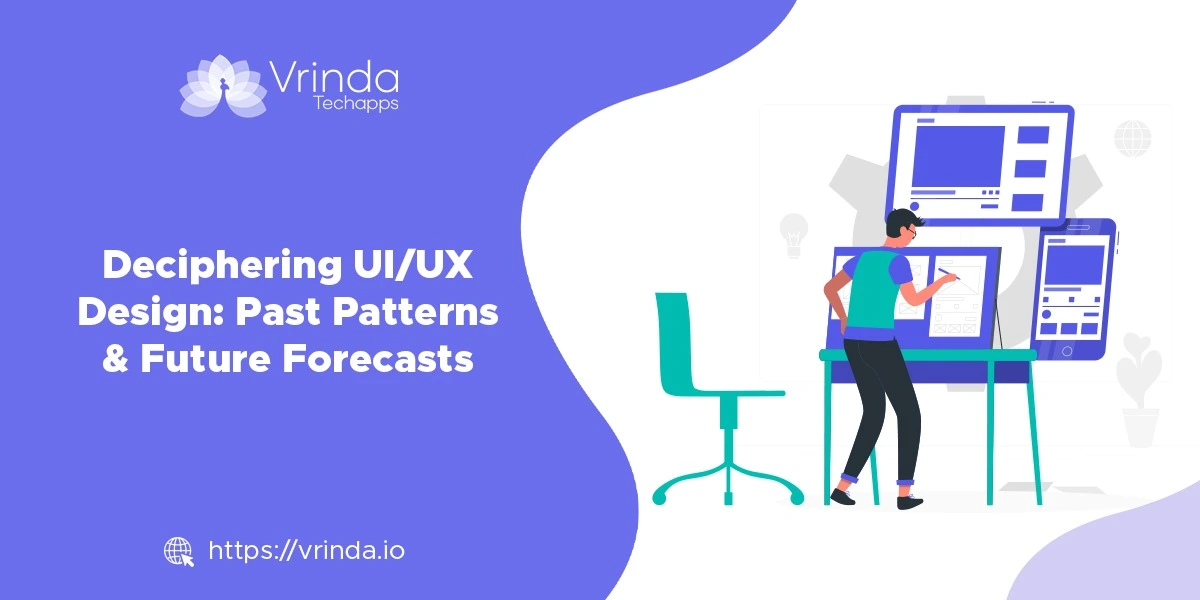
Deciphering UI/UX Design: Past Patterns & Future Forecasts
- October 10, 2023
- 3 min read
In the digital realm, the tale of UI/UX design is as riveting as an age-old saga. Journeying from the rudimentary designs of the early internet days to today’s intricate, user-centric interfaces, the metamorphosis is noteworthy. So, let’s traverse this timeline, understanding the transformative eras and anticipating what’s in store for businesses determined to remain at the forefront.
Beginnings: Design in Its Infancy
In the early days of the digital age, the primary aim of websites and applications was straightforward: deliver information. There was minimal emphasis on elegance or user engagement. Thus, screens from the 90s were dotted with uncomplicated layouts, coarse images, and those iconic blue hyperlinks.
The Mobile Epoch: Redefining Norms
As we stepped into the 21st century, the advent of mobile technology heralded significant shifts in UI/UX design perspectives. The confined space of mobile screens demanded designs to be fluid, paving the way for ‘responsive’ interfaces. The narrative soon changed from creating “for the desktop” to ideating “with mobile in mind.”
Fusing Traditions with Modernity
As the web cast its net far and wide, it was evident that universally standardized designs weren’t going to resonate with everyone. UI/UX design company in Hyderabad began to absorb and reflect local hues, typographies, and cultural nuances, offering a delightful blend of the traditional and contemporary.
The Era of Custom Experiences and Emotional Connects
Today, the essence of UI/UX lies in personal touch points and eliciting emotions. Businesses now understand the power of curating tailored experiences. Cutting-edge tech like AI and machine learning drives dynamic interactions, transforming screens from mere display units to engaging conversationalists.
What Stirred These Design Evolutions?
The shifts in UI/UX paradigms weren’t random but influenced by specific triggers. Allow me to guide you through these pivotal contributors:
Tech Tides: The relentless surge in technology has reshaped our digital interfaces. Augmented Reality (AR) has emerged as a game-changer, merging our tangible surroundings with digital overlays. On the other hand, Virtual Reality (VR) envelopes users in meticulously designed alternate worlds, creating engrossing experiences. Parallelly, Artificial Intelligence (AI) is weaving its magic quietly but decisively, refining interfaces to become anticipatory, adaptive, and inherently smart. Together, these technological wonders have redirected UI/UX design on a path brimming with innovation and discovery.
Evolving User Desires: Cast your mind back to a time when the allure of the internet was purely its novelty. Zoom into the present, and you find a generation of users accustomed to the zenith of digital sophistication. Their expectations have grown, demanding more than mere digital operability. They yearn for captivating visuals, seamless engagements, and designs that resonate emotionally. This shift in user tastes has ignited a ceaseless fire in designers, urging them to continuously reinvent and elevate their craft.
Seamlessness Across Devices: Remember the era dominated by desktops as the primary digital portals? Fast forward, and today’s reality paints a varied picture. A person could be sifting through emails on a mobile in the morning, transition to a laptop for official tasks, leisurely browse on a tablet, and perhaps immerse in a VR escapade by nightfall. Such gadget diversity underscores the importance of design continuity, ensuring that users are treated to a consistent and engaging experience, irrespective of their choice of device.
Market Rivalries: Today’s digital space is akin to a high-stakes arena, teeming with businesses grappling for user engagement and commitment. In this heated milieu, possessing a distinctive and user-attuned design can be a monumental edge. Organizations are perpetually searching for that unique design flair that sets them apart in an oversaturated market. This fervent rivalry not only fosters fresh design thinking but also promotes the embracing of top-tier UI/UX practices, assuring users always relish the cream of the crop.
Peering Ahead: What Might the Future Hold?
Predicting the unpredictable world of UI/UX might be challenge, but certain directions seem likely:
1. Conversations with Voice: As devices that respond to our voice become common, crafting voice-centric interfaces will be crucial.
2. AR-Driven Interactions: With easier access to AR tools, more digital platforms will weave in augmented experiences.
3. Neomorphism’s Rise: Straddling the line between realism and minimalism, neomorphism offers a fresh design approach that’s catching the eye.
4. Predictive UX via AI: Leveraging AI to anticipate user actions will pave the way for more intuitive user journeys.
5. Eco-conscious Designing: The global shift towards sustainability will reflect in design ethos, emphasizing green practices and societal goodwill.
6. Harmonizing Distance Work: As businesses scatter across geographies, UI/UX will play its part in making distant collaborations feel as warm and effective as in-house team huddles.
7. Creating a Digital Welcome Mat for All: The mantra for future businesses will be inclusivity. Upcoming digital designs will ensure that everyone, from tech enthusiasts to digital newcomers, finds a space where they feel acknowledged and valued.
Wrapping Up
The world of UI/UX design, with its twists and turns, mirrors an evolving narrative. For businesses aiming to stay relevant, it’s crucial to both cherish the milestones achieved and gear up for the upcoming design revolutions. By doing so, they can ensure that their digital offerings remain engaging, relevant, and user-friendly.
If you are looking for the best UI/UX designers, look no further than Vrinda Techapps. We are a leading mobile app development company in Hyderabad, offering innovative and customized solutions to businesses of all sizes.



